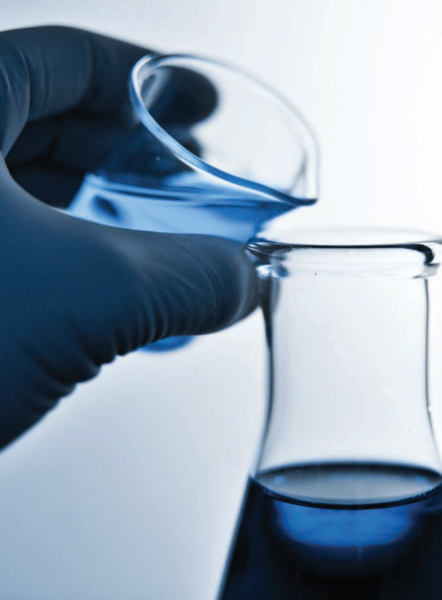Entomologist and IPM researcher, Dr. Michael Gaffney, Entomologist and IPM researcher working in the Horticulture Department in Teagasc, provides overview and insight on Irish based research in edible horticulture
Production of vegetable crops in Ireland is facing continuous downward price pressure while having to react to increasing legislation and customer demands for more sustainable production systems. While demand for Irish product is high, the return to growers does not necessarily match the input costs and the associated risks involved in growing such crops. Attempting to provide research to this sector with its diverse needs is challenging. Underpinning, protecting and improving the sustainability and profitability of this sector is the driving focus of my research.
IPM AND BIOCONTROL
The plant protection chemistry available to growers is becoming more limited and more restrictive. A combination of European Directives in the area of pesticides and water protection will further reduce the number of active ingredients available to growers. In January 2014, the Sustainable Use of Pesticides Directive came into legislation in Ireland, requiring growers to grow in an IPM compliant manner. While the development of biological and cultural pest and disease control techniques are well advanced under protection. The efficacy of these approaches outdoors is less well developed. It is predicted that by 2020 50% of the plant protection products available in the EU will be pathogens, predators, parasitoids, or natural extracts. It is essential that we gain a greater understanding of the advantages and disadvantages of using these approaches outdoors in Ireland. Preliminary studies at Kinsealy have identified that entomopathogenic (insect-killing) nematodes, similar to those used to control vine weevil in soft fruit, can infect and kill cabbage root fly, a serious pest of field brassicas. However, the injurious first generation, which usually arrives in May, coincides with relatively low soil temperatures. In general insect-killing nematodes are not particularly effective below 120C. Collaborative work between Teagasc and NUI Maynooth has identified that storing these nematodes at low temperatures or ‘conditioning’ them for a number of weeks before application significantly increases their efficacy at temperatures between 8-120C. This effect was consistent across four different nematode species and indicates that nematode manufacturers may be able to increase the efficacy of their products, potentially making them a viable alternative to pesticides outdoors in north-west Europe. Nematodes are potentially effective against a wide range of fly and caterpillar pests.
PLANT EXTRACTS
In combination with biological methods, there is also the potential of using chemicals extracted from plants to control pest populations; however, their effect may be more subtle than the traditional ‘knock down’ effect we see with more conventional pesticides. Using the vine weevil as a model pest, work in Teagasc has identified that an extract of the neem tree (azadirachtin).
Azadirachta indica has significant potential to control pest populations. By feeding adult weevils with azadirachtin treated foliage we were able to reduce adult egg laying by over 95%, with the subsequent viability of any eggs laid reduced by a further 50%. There was no effect on overall adult weevil mortality and the levels of azadirachtin needed to cause this effect have been shown to have little or no significant effect on beneficial insect species. Using mathematical models of the vine weevil life history, we were able to estimate that by year three? populations of weevils on a nursery could be reduced to nearly zero. However, it is not only exotic plant species which contain chemicals with these interesting effects. Ongoing work in conjunction with the Dublin Institute of Technology has developed a rapid low-cost detection method for such compounds and has subsequently identifi ed several compounds from common Irish plants which may have potential as plant protection agents.
CREATING PEST SUPPRESSIVE SOILS
Good soil husbandry is fundamental to sustainable long-term crop production and plant health and is a real focus of growers, both conventional and organic. We have been investigating the effect soil management and crop protection techniques have on soil biology and as a consequence on disease management in those crops. Using molecular techniques we were able to assess that organic soil management and organic pest control strategies had a beneficial effect and reduced the number of potential onion diseases found in the soil when compared with conventionally managed crops. Also, bacterial species associated with disease suppression (Lysobacter sp. and Actinomycetes) were recovered mainly from plots where organic pest control strategies were practiced. Overall the results indicated that organic soil management practices had a beneficial effect on soil health, microbial activity and diversity. A follow-on collaborative study with the Scottish Rural College (SRUC), funded by Teagasc and the Horticultural Development Company in the UK, have indicated that brassica crops grown in organic plots were subjected to twice the rate of cabbage root fly egg laying than crops grown in conventionally managed plots. This study is ongoing and we are attempting to understand the mechanisms at play and also the
contribution of beneficial insects and organisms, such as fungi and nematodes present in the soil and what role they play in regulating the severity of pest outbreaks.
The application of organic amendments can be critical to maintaining good soil health and subsequently, a healthy crop. Each year nearly 500,000 tonnes of brown bin or food waste is produced in Ireland. This material needs to go through a treatment process, usually composting. The resulting material can be inconsistent and through an Environmental Protection Agency funded project we are attempting to gain a better understanding of and develop methods to better predict the potential nutrient value of such materials. Our studies to date indicate that only 7-8% of the total nitrogen content of a composted food waste is readily plant available. Generally, green waste composts display 0% nitrogen availability and indeed in many cases cause nitrogen immobilisation. Traditionally, characteristics such as C:N ratio have been used to predict nitrogen availability in homogenous materials such as spent mushroom compost. We have been able to establish that for heterogeneous materials such as food waste composts C:N is not an accurate predictor of nitrogen availability and that factors, such as the quality of the carbon
available are a more important predictor of nitrogen release. Generally, it is accepted that phosphorus release from composted wastes is 100% of total phosphorus. Our studies indicate that the level of availability is closer to 60%, which will have a major influence on achieving a balance between applying adequate phosphorus for optimal plant growth while minimising any detrimental environmental effect. A major conclusion of this study is that compost application to field crops should be based on the phosphorus content of the material and not the nitrogen content.
Obviously, application of compost has other benefits, aside from supplying plants with nutrients. Composted food wastes have been found to be high in humic substances, which are important for soil health and carbon sequestration. Composts also provide a large community of beneficial microbiology, many of which have the ability to limit the severity of disease outbreaks. In conjunction with UCD we investigated the disease suppressive capabilities of 15 different composts. Pathogens such as Pythium sp. and Phytophthora sp. were largely suppressed by the addition of compost whereas Fusarium pathogens were not. Using dual culture techniques we were able to identify and isolate many isolates of the genus Trichoderma which are widely used as biological control agents. Our studies indicate that disease suppressive Trichoderma species can be inoculated into composted heaps and will survive and multiply during the composting process, creating consistent disease suppressive composts. This approach could help the Irish composting industry to produce consistent disease suppressive composts and provide growers with a new crop protection strategy to reduce the severity of soil-borne diseases and improve general soil health.
PRODUCT DEVELOPMENT
Irish growers are constantly attempting to differentiate their products from imported produce. Through the Irish Phytochemical Food Network (www.ipfn.ie), we are attempting to identify vegetable varieties, agronomic methods and minimal processing techniques which Irish growers can use to add value to their produce. To date, we have been able to identify carrot varieties with high levels of naturally occurring polyacetylenes such as Falcarinol. Falcarinol has been shown in animal models to reduce the risk of cancerous tumors, as well as being anti-bacterial and anti-inflammatory. Falcarinol itself also has a positive effect on the carrots as it protects them from fungal diseases. We have also investigated how to retain these beneficial chemicals through minimal processing. Work at Teagasc has identified that carrots cut into batons or disks will retain significantly more of these beneficial compounds over 15 days than those that are shredded or cubed. Similar work on beneficial compounds in brassicas, known as glucosinolates, and quercetins in onions, has also been done.
THE WAY FORWARD
Given the structure and size of the Irish horticulture sector, it is important for it to constantly differentiate itself from imported produce by maintaining its high sustainability credentials and also by being innovative. Sectors such as the dairy, beef and others have shown the real benefits of investing in research at the production level, but we must also remember the real input production research, at institutes like Teagasc, had in the early development of our mushroom and glasshouse sectors. Current research capacity in horticulture in Ireland is small, but with good coordination and cooperation, between institutes both nationally and internationally, real progress can be made, particularly where growers become actively involved and help direct research. For research capacity to significantly increase in Ireland, it will most likely need direct investment from the industry to make it happen. It must be remembered that vegetables and fruit are the two largest fresh food categories, valued at approx. €1.2bn per year. As the Irish population grows, becomes more health aware and begins to dictate the production practices it wants (and doesn’t want), there is a real opportunity for Irish growers to react, adopt new technologies and begin to increase their market share. Good, grower-focused production research will be central to achieving this. ✽
 DR MICHAEL GAFFNEY is an entomology and IPM researcher working in the Horticulture Department in Teagasc, having previously worked at the University of Wales, Swansea and UCD. He leads a diverse research group focusing on crop protection and crop quality issues. He can be contacted at Michael.Gaffney@Teagasc.ie DR MICHAEL GAFFNEY is an entomology and IPM researcher working in the Horticulture Department in Teagasc, having previously worked at the University of Wales, Swansea and UCD. He leads a diverse research group focusing on crop protection and crop quality issues. He can be contacted at Michael.Gaffney@Teagasc.ie |





